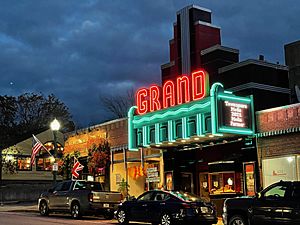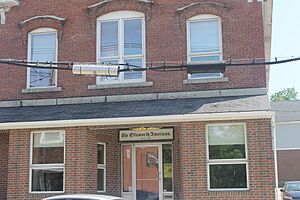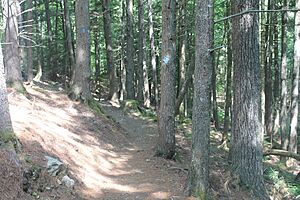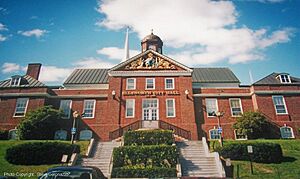Ellsworth, Maine facts for kids
Quick facts for kids
Ellsworth, Maine
|
||
|---|---|---|
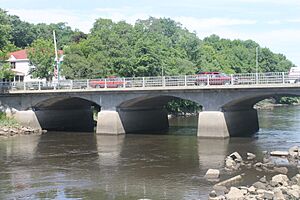
Bridge over the Union River in downtown Ellsworth
|
||
|
||
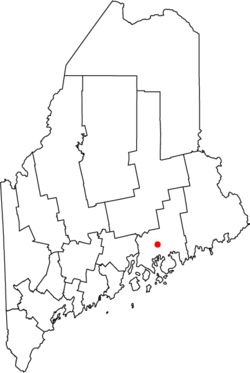
Location of city of Ellsworth in the state of Maine
|
||
| Country | United States | |
| State | Maine | |
| County | Hancock | |
| Settled | 1763 | |
| Incorporated (town) | February 26, 1800 | |
| Incorporated (city) | February 8, 1869 | |
| Villages | Ellsworth Falls North Ellsworth West Ellsworth |
|
| Area | ||
| • Total | 93.92 sq mi (243.25 km2) | |
| • Land | 79.29 sq mi (205.35 km2) | |
| • Water | 14.63 sq mi (37.90 km2) | |
| Elevation | 108 ft (33 m) | |
| Population
(2020)
|
||
| • Total | 8,399 | |
| • Density | 105.93/sq mi (40.90/km2) | |
| Time zone | UTC−5 (Eastern (EST)) | |
| • Summer (DST) | UTC−4 (EDT) | |
| ZIP code |
04605
|
|
| Area code(s) | 207 | |
| FIPS code | 23-23200 | |
| GNIS feature ID | 0565863 | |
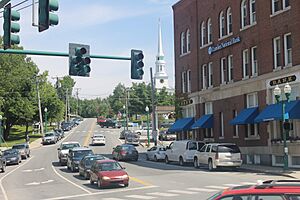
Ellsworth is a city in Maine, United States. It is the main city of Hancock County. In 2020, about 8,399 people lived there. The city is named after Oliver Ellsworth, one of the Founding Fathers of the United States. Ellsworth has many old buildings and interesting places to visit. It is also close to Acadia National Park, a popular natural area.
Contents
History of Ellsworth, Maine
Early Native American Settlements
Long ago, the area where Ellsworth is now was home to the Passamaquoddy and Penobscot tribes. These groups spoke similar Algonquian languages. They were known for traveling long distances in their canoes.
European Explorers and Claims
The first Europeans to explore this region were the French in the 1500s. Later, English explorers like Martin Pring and Captain Weymouth sailed along the coast in the early 1600s. Both France and England claimed this land. This led to many wars between them. The area was called "Acadie" by the French. It remained mostly wild during these times.
First European Settlers Arrive
Modern Ellsworth began around 1763. English settlers, led by Benjamin Milliken and Benjamin Joy, came to the Union River area. They wanted to build dams and sawmills. They used the area's timber and water power to create businesses. These pioneers built their first simple homes near the present-day Water Street.
Becoming a Town: Ellsworth's Name
In 1773, the first schooner (a type of sailing ship) was built in Ellsworth. It was named the Susan and Abigail. This ship carried wood products to the West Indies. For many years, shipyards along the Union River built many schooners.
In the late 1700s, the area was known as the Union River Settlement. In 1800, it officially became a town. It was named Ellsworth after Oliver Ellsworth. He was an important person who helped create the U.S. Constitution. He also suggested the name "United States of America."
Ellsworth in the 1800s
In 1838, Ellsworth became the main city for Hancock County. This meant important county buildings were built there. By 1859, Ellsworth had many businesses. These included sawmills, tanneries, and shipbuilders.
During the Civil War (1860-1865), Ellsworth sent many soldiers to fight. About 653 men from Ellsworth joined the army. In 1869, Ellsworth officially became a city.
Major Events of the 20th Century
Electricity came to Ellsworth in 1888. In 1907, work began on a hydro-electric dam on the Union River. This dam created Leonard's Lake, which is just north of the city.
Ellsworth faced a big flood in 1923. The flood washed away the Union River Bridge and many buildings. This event ended Ellsworth's time as a major shipping center. A new concrete bridge was built in 1924.
In 1933, a huge fire destroyed most of downtown Ellsworth. New buildings were then built using brick, often in the Art Deco style. The unique Ellsworth City Hall was built during this time.
In the 1960s and 1970s, a new shopping area grew on High Street. This area is now the biggest shopping district in Hancock County.
Postcards of Ellsworth
-
Col. John Black House, built 1824–1827. It is now part of Woodlawn Museum.
Geography and Location
Ellsworth is located at 44°34'20" North and 68°28'34" West. The city covers about 93.92 square miles (243.25 square kilometers). Most of this area is land, but about 14.64 square miles (37.90 square kilometers) is water. The Union River flows through Ellsworth.
Ellsworth Falls has a special place called the Agassiz Outcrop. This spot is famous because it showed early proof of glaciation (when glaciers covered the land).
Several important roads pass through Ellsworth. These include U.S. Route 1 and U.S. Route 1A.
Neighboring Cities and Towns
 |
Dedham | Otis | Mariaville |  |
| Orland | Hancock | |||
| Penobscot | Surry | Trenton |
Climate in Ellsworth
Ellsworth has a humid continental climate. This means it has warm summers and cold, snowy winters. Even though it is at a similar latitude to southern France, its weather is much colder. This is because of weather patterns from the west and the cold Labrador Current.
Population and People
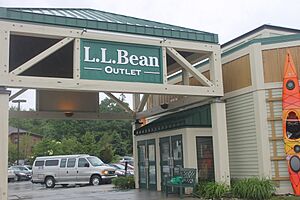
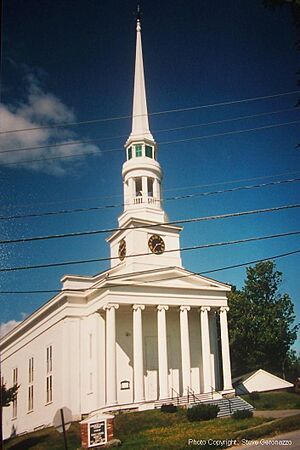
Ellsworth has grown steadily over the years. In 1800, only 227 people lived there. By 2020, the population had grown to 8,399 people.
| Historical population | |||
|---|---|---|---|
| Census | Pop. | %± | |
| 1800 | 227 | — | |
| 1810 | 614 | 170.5% | |
| 1820 | 892 | 45.3% | |
| 1830 | 1,385 | 55.3% | |
| 1840 | 2,263 | 63.4% | |
| 1850 | 4,009 | 77.2% | |
| 1860 | 4,658 | 16.2% | |
| 1870 | 5,257 | 12.9% | |
| 1880 | 5,052 | −3.9% | |
| 1890 | 4,804 | −4.9% | |
| 1900 | 4,297 | −10.6% | |
| 1910 | 3,549 | −17.4% | |
| 1920 | 3,058 | −13.8% | |
| 1930 | 3,557 | 16.3% | |
| 1940 | 3,911 | 10.0% | |
| 1950 | 3,936 | 0.6% | |
| 1960 | 4,444 | 12.9% | |
| 1970 | 4,603 | 3.6% | |
| 1980 | 5,179 | 12.5% | |
| 1990 | 5,975 | 15.4% | |
| 2000 | 6,456 | 8.1% | |
| 2010 | 7,741 | 19.9% | |
| 2020 | 8,399 | 8.5% | |
| U.S. Decennial Census | |||
Places to Visit in Ellsworth
There are several interesting places to visit in Ellsworth:
- Birdsacre—Stanwood Homestead Museum & Wildlife Sanctuary: A place to learn about nature and wildlife.
- Ellsworth Historical Society Building: Learn about the city's past.
- Ellsworth Public Library: A great place to read and learn.
- The Grand: A historic theater where you can watch performances.
- Telephone Museum: Discover the history of telephones.
- Woodlawn Museum—the Black House: A historic house and museum.
Famous People from Ellsworth
Many notable people have connections to Ellsworth:
- Johannes Bapst: A missionary and educator.
- Curt Fullerton: A baseball player.
- Eugene Hale: A U.S. Senator.
- Marsden Hartley: A famous American painter.
- Clarence Cook Little: A geneticist (someone who studies genes).
- Benjamin Milliken: One of the founders of Ellsworth.
- Bryant Moore: A major general in the military.
- John A. Peters (1822–1904): A U.S. Congressman.
- John A. Peters (1864–1953): Another U.S. Congressman, nephew of the first John A. Peters.
- Darryl Pollard: A football player.
- Dick Scott: A shortstop for the Oakland Athletics baseball team.
- Cordelia Stanwood: A teacher, ornithologist (bird expert), and wildlife photographer.
- Tim Sylvia: A former UFC Heavyweight champion in mixed martial arts.
- John Hay Whitney: A publisher and ambassador.
See also
 In Spanish: Ellsworth (Maine) para niños
In Spanish: Ellsworth (Maine) para niños




